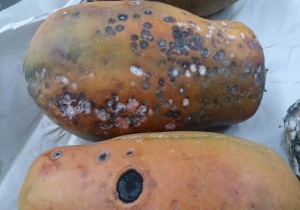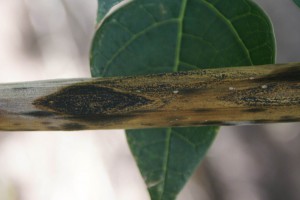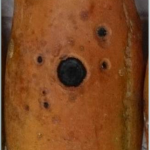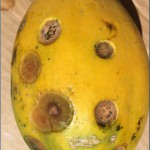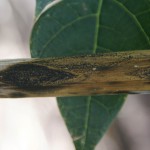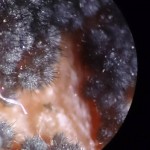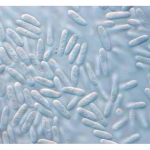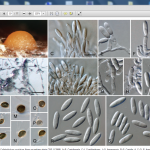Colletotrichum
Anthracnose in Papaya / Colletotrichum.
The disease known as “Anthracnose” is undoubtedly the most important disease in the post-harvest stage and perhaps, the one that causes the greatest economic decline in this crop.
This disease is widely distributed and affects leaves, stems, flowers, petioles, and mainly fruits; where their damages are numerous. Anthracnose (canker or chancre) is caused by several species of the fungus Colletotrichum.
Symptom.
The characteristic symptoms of this disease are circular lesions sunk into fruits that turn different colors such as Black, Brown or White – Cream; or the combination of both, depending on the species involved.
On the other hand in the petioles of the leaves small black dots are formed, which remain when they fall to the ground, place from which subsequent infections can occur for the plants around them.
Figure 1. Typical anthracnose caused by Colletotrichum Truncatum (Capsici).
Figure 2. Typical anthracnose caused by Colletotrichum Gloeosporioides.
Figure 3. Anthracnose lesions caused by Colletotrichum Acutatum in combination with Colletotrichum Truncatum.
Figure 4. Mass of black anthracnose acérvules caused by Colletotrichum Truncatum.
In the case of Colletotrichum Truncatum, the mass of acérvulos shows thorns (mushrooms) of black color and a mass of gray color, conformed by the conidia themselves that give the coloration both in fruits and petioles.
Figure 5. Mass of Colletotrichum Truncatum acérvules, showing black spines and gray spore mass.
Three species have been reported in some regions of Mexico:
- Colletotrichum Truncatum (Capsici)
- Colletotrichum Gloeosporioides
- Colletotrichum Acutatum
The species mainly found in Mexico show different conidia, which allow them to differentiate themselves from each other.
Figure 6. Conidia typical of C. Truncatum
Terms.
The climatic conditions that favor the incidence of anthracnose are:
- Temperatures close to 28ºC, in a range of 20 to 30ºC.
- Relative humidity of the air over 95%.
The germination of the conidia requires free water and these are released from the collections when the relative humidity is greater than 95%, in most of the producing regions of Mexico the greatest severity can occur in the months between September and March.
Anthracnose Control
- Elimination of inoculum sources: Removal of infected fruits and senescent leaves of the plant.
- Irrigation management and balanced fertilization:
High doses of Ca (50 grams / plant) and B (0.77 grams / plant) contribute an almost 70% increase in the incidence of anthracnose in fruits, compared with doses of 0.06 grams. of B / plant and 2.5 grs. of Ca / plant (Tatagiba et al., 1998).
- Mineral application
Application of Calcium Chloride at a dose of 1.5 L or Kg / hectare for 5 to 6 occasions with intervals of one week starting 6 weeks before harvest.
Preventive application of potassium silicate at a dose of 1.0 L. / hectare, reduces the deterioration of fruits caused by Colletotrichum gloeosporoides; It is recommended to apply it 3 times every 15 days, starting 2 months before harvest, compatibility and phytotoxicity tests should be carried out especially if mixed with calcium chloride.
Chemical control
Preventive:
- Apply contact fungicides such as: Copper hydroxide 2 grs./L. of water; Mancozeb 3 grs./L., Chlorothalonil 2 grs. or mL per liter of water.
- The application of systemic fungicides will depend largely on the species that cause anthracnose:
Fungicides recommended for the control of different species of Colletotrichum.
| Fungicide | Dose mL or gr per liter of water | Species that controls |
| Azoxystrobin (C3 *) + Cyprodinil (D) | 4 | C. gloeosporioides
C. truncatum |
| Fludioxonil (E) + Cyprodinil (D) | 1.23 | C. gloeosporioides
C. truncatum C. acutatum |
| Thiabendazole (B) | 1.15 | C. gloeosporioides
C. acutatum |
| Azoxystrobin (C3) + Diphenoconazole (G) | 0.76 | C. gloeosporioides
C. truncatum C. acutatum |
| Isopyrazam (C2) | 1.3 | C. gloeosporioides
C. truncatum C. acutatum |
| Boscalid (C2) + Pyraclostrobin (C3) | 1.25 | C. gloeosporioides
C. acutatum |
| Trifloxystrobin (C3) | 0.25 | C. gloeosporioides |
Note: The letter and number in parentheses indicate the mode of action of the fungicide according to FRAC (Action Committee on
Fungicide Resistance ).
Copyright © All Rights Reserved.
Semillas del Caribe / One Step Ahead
- Herida por hongo
- Hongo en fruta
- Hongo en fruta
- Daño en hoja y tallo
- Daño
- Colonia de hongos
- Colonia de hongos


